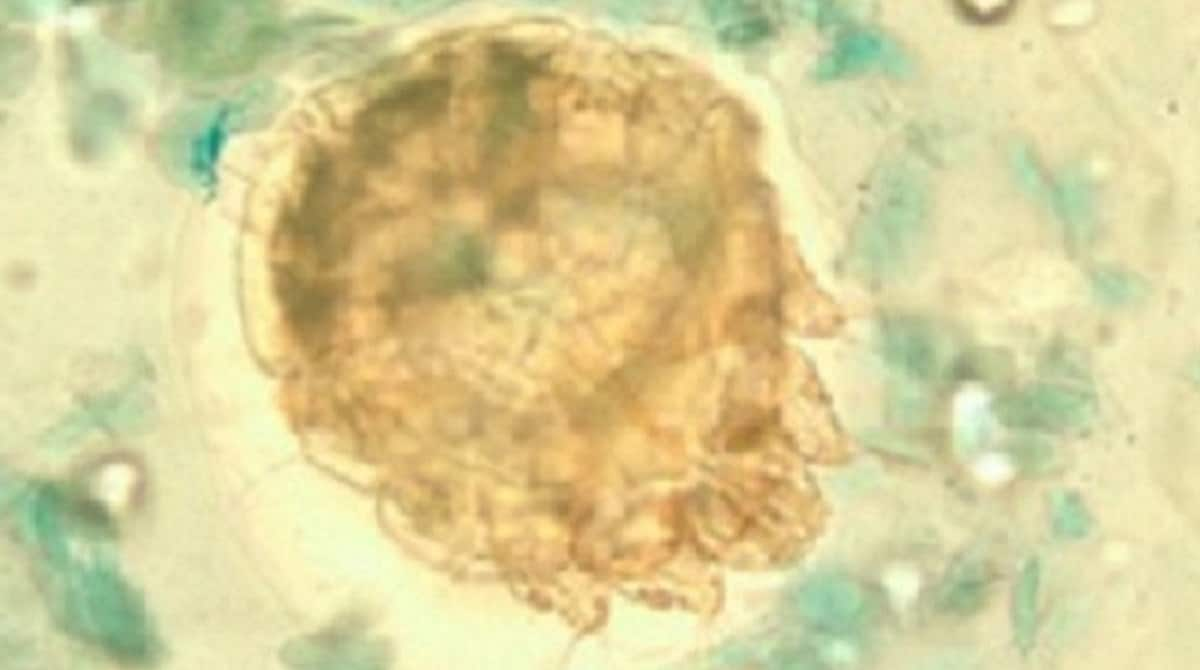Key points
- Scabies is an infestation of the skin by a human itch mite.
- Scabies causes intense itching and a pimple-like skin rash.
- Human scabies is most commonly spread by direct, prolonged skin-to-skin contact with a person who has scabies.
- Anyone can get scabies.

Overview
Scabies is caused by the human itch mite (Sarcoptes scabiei var. hominis). The microscopic scabies mite burrows into the upper layer of the skin where it lives and lays its eggs. Scabies can spread quickly under crowded conditions where close body and skin contact is frequent.
The most common symptoms of scabies are intense itching and a pimple-like skin rash.
Signs and symptoms
The most common symptoms of scabies are intense itching, especially at night, and a pimple-like skin rash. Common areas on body where symptoms occur include:
- between fingers,
- in the skin folds of the wrist, elbow, knee, or armpit, and
- on the penis, nipples, waist, buttocks, and shoulder blades.
You may see tiny burrows on the skin, caused by the female mite tunneling just beneath the surface of the skin.
Infants and very young children often experience a rash on the head, face, neck, palms, and soles of the feet.
Crusted scabies
Risk factors
Scabies is a common condition found worldwide. It can spread to anyone through close, personal, often skin-to-skin contact. Scabies can spread easily under crowded conditions where close body and skin contact is frequent.
Places where scabies outbreaks more commonly occur include:
- Nursing homes
- Extended care facilities
- Detention facilities including jails and prisons
- Childcare facilities
How it spreads
You can get scabies by
- Direct, extended, skin-to-skin contact with a person who has scabies or
- Less commonly, sharing clothing, towels, or bedding used by an infected person.
- Homeless shelters or encampments.
Prevention
When a person is infested with scabies mites the first time, symptoms typically take 4 – 8 weeks to develop. However, a person with an infestation can transmit scabies even if they do not have symptoms.
To prevent scabies, avoid direct skin-to-skin contact with a person who has scabies. Avoid sharing items such as clothing or bedding used by a person who has scabies.
Control
To control the spread of scabies, treat all household members and close contacts at the same time as the person with scabies. This should help to prevent possible re-exposure and reinfestation. Wash all clothing, towels, and bedding used next to the skin during the three days before starting treatment. Items should be machine washed using hot water (temperatures in excess of 50°C or 122°F for 10 minutes will kill mites and eggs), dried on the hot cycle, or dry-cleaned. Seal items you can't wash or dry-clean in a closed plastic bag for several days to a week. Scabies mites generally do not survive more than two to three days away from human skin. Children and adults can usually return to childcare, school, or work the day after treatment.
Diagnosis
Your healthcare professional can sometimes diagnose scabies based on physical exam findings and history but will likely try to confirm scabies by finding the mite, mite eggs, or feces (scybala). They may scrape your skin or use the tip of a needle to carefully remove the mite from the end of its burrow. The sample is examined under a microscope to confirm scabies.
A person can still have scabies even if mites, eggs, or feces are not found. Fewer than 10 – 15 mites may be present on an infected person who is otherwise healthy.
Treatment and recovery
The first time a person gets scabies they usually have no symptoms at the beginning. Symptoms can take four to eight weeks to develop after infestation; however, people can still spread scabies during this time.
If you suspect you have scabies, seek medical attention. Your healthcare professional can prescribe a cream, lotion, or pill that kills scabies mites.
To prevent the spread of scabies
- Treat other household members with whom you have had direct skin contact or have shared a bed, towels, or clothing at the same time.
- Wash bedding, clothing, and towels in hot water and dry in a hot dryer. Temperatures in excess of 50°C or 122°F for 10 minutes will kill mites and eggs.
- Dry-clean items that can’t be washed or seal them in a closed plastic bag for at least 72 hours to a week.
- Avoid skin-to-skin contact with others until treatment is complete.
- Notify people you had direct skin-to-skin contact with during the previous two months and encourage them to seek treatment.
Scabies mites generally do not survive more than two to three days away from human skin.
Products used to treat scabies (scabicides) kill scabies mites; some also kill mite eggs. Scabicides require a doctor's prescription. No non-prescription products have been tested and approved to treat scabies. Carefully follow the instructions contained in the box or on the label. Scabicide lotion or cream should be applied to all areas of the body from the neck down to the feet and toes. For infants and children, the lotion or cream should be applied to their entire head and neck as well as the rest of the body. Only permethrin or sulfur ointment may be used in infants. The lotion or cream should be applied to a clean body and left on for the recommended time before washing it off.
The itching of scabies is due to a hypersensitivity reaction (allergy) to mites and their feces, so itching may continue for several weeks after treatment even if all the mites and eggs are killed. However, if itching still is present two to four weeks after treatment or if new burrows or pimple-like rash appear, retreatment may be necessary.
